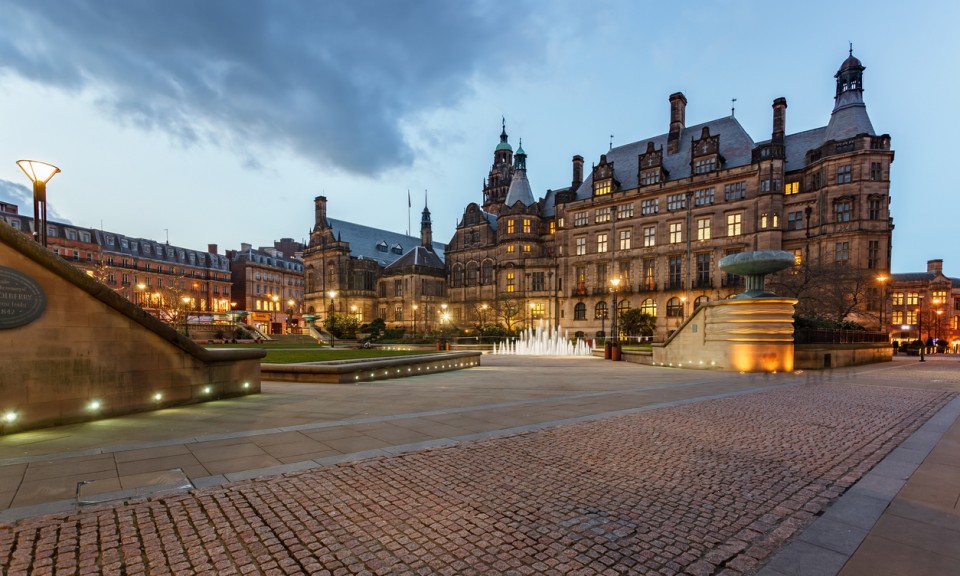WHY WE LOVE SHEFFIELD
INTRODUCTION…THE STEEL CITY
World-renowned for its iron and steel industries, Sheffield played a crucial role in the Industrial Revolution, with many significant inventions and technologies developed in the city. In the 19th century, the city saw a huge expansion of its traditional cutlery trade, when stainless steel and crucible steel were developed locally, fuelling a large increase in the population and cementing Sheffield’s reputation for innovation and creativity.
Although international competition caused a decline in the iron and steel industries in the 1970s and 1980s, and coupled with the collapse of the coal industry, Sheffield has recovered from the fallout of the industrial decline and is blossoming once more, enjoying extensive redevelopment with a 60% increase in GVA since 1997 and a steady annual growth averaging 5%.

Sheffield has developed beyond all recognition over the last decade with investors demonstrating huge confidence shown by the growing business base and evolving skyline. A deal with the Government promises to pump £1.3 billion into the local economy over the next 30 years giving Sheffield decision making powers on infrastructure, transport and housing thus driving business growth. The Sheffield City Region Strategic Economic Plan 2015-2025 set expansive economic goals for the region, including generating an additional £3 billion GVA, adding 70,000 jobs and creating a further 6,000 businesses – a target that is well on the way to being exceeded.

The name Sheffield comes from the River Sheaf, one of several rivers that run through the city, along with the River Don and the River Loxley.
The world famous crucible theatre is named after the steel making process.
Sheffield is built on 7 hills… just like Rome!
There’s a National Park in the city. Around a third of the city is actually inside the Peak District National Park – no other city in the UK has part of a National Park inside its boundaries. Sixty-one per cent of Sheffield’s entire area is green space, and a third of the city lies within the Peak District National Park. The Peak District National Park became the first national park in the United Kingdom in 1951. It attracts millions of visitors every year.
Sheffield is home to the oldest football club in the world that plays association football. Sheffield FC was founded in 1857 by members of a cricket club based in Sheffield.The team adopted the official FA rules in 1878 and they now play in the Northern Premier League. As well as Sheffield FC, the city is also home to Sheffield Hallam FC which is the second oldest football club in the world, having been founded just three years after Sheffield FC.
Sheffield also has the world’s oldest football ground, Sandygate , ground of Hallam F.C. The club has played at their grounds in Crosspool since its formation, earning the Sandygate Road pitch a place in the Guinness Book of Records as the oldest ground in the world.
The city has four trees for every person. Sheffield is home to more than two million trees – that’s the highest ratio of trees to people for any city in Europe.
The city also has around 250 parks, woodland areas and gardens, including Crookes Park, Norfolk Heritage Park and the Botanical Gardens.
The Crucible Theatre is cursed. For nearly 40 years, the Crucible Theatre in Sheffield has been home to the World Snooker Championship, the leading professional snooker tournament with regards to prestige, prize money and points available. Since the tournament has taken place at the Crucible, no player has been able to defend their first title win – a strange but true phenomenon commonly referred to as the Crucible Curse.
Sheffield has its own Walk of Fame. Located outside the Town Hall, are a number plaques in the shape of stars engraved with the names of famous sons and daughters of Sheffield and why they are well known. Athletes Jessica Ennis and Sebastian Coe and actor Sean Bean are among the names that make up this ‘Walk of Fame’.
The world’s longest lasting rainbow was only visible from Sheffield. The record breaking rainbow was visible above the skies of the Steel City for six hours on March 14 1994.
Sheffield town was incorporated as a borough in 1843 and granted a city charter in 1893.
Although its industrial base underwent some shrinkage in the late 20th century, Sheffield is still a major British producer of raw steel, cutlery, and machinery.
The most people tossing pancakes is 890 and was achieved at an event organised by the University of Sheffield (UK), in Sheffield, UK, back in 2012.
The most people playing hopscotch simultaneously is 664, and was achieved by Move More Sheffield (UK) in Sheffield, UK, on 20 May 2019.
The city runs on recycled energy. Sheffield has a district energy system that uses domestic waste to produce thermal energy which is converted to electricity and hot water. Over 225,000 tons of waste each year produces about 19 megawatts and 60 megawatts of thermal energy.
Residents sing Christmas carols at pubs. Christmas carols in this great city are sung at pubs with a hearty mug of beer in your hands. Nothing better than to celebrate the joyous occasion with friends while loading up on pints of beer. The unique choice of location is not the only different thing about carols. Most of the Christmas carols sung in Sheffield are unique to the city and you won’t find them anywhere else or at any other times of the year. The tradition is so popular that carollers are even accompanied by brass bands to give the occasion a dice of spice.
The steel used in the Brooklyn Bridge was forged in Sheffield. Supposedly, the steel used to make the iconic structure was forged in Sheffield. Given how popular Sheffield was as a metal market back in the day, it makes perfect sense that the steel used in one of the most breathtaking architectural feats was forged in Steel City.
Sheffield has been voted the UK’s most popular destination among students. With a rich and free-spirited culture, fun activities, pubs, and clubs along the west and Carver streets, it’s not a wonder that most students prefer to come to Sheffield to study. Other than the world-class institutions the city boasts of, there are the £1 Jagger bombs that are hard to ignore and favourite among the students.
More than half of the world’s surgical blades are produced in Sheffield. The steel industry in Sheffield might not be what it used to be. But, it’s still very vibrant and strong. So much so that Sheffield produces as much as half of the world’s surgical blades used in hospitals. This incredible fact shows the impact this city has all across the world helping save lives by making high-quality steel products.
The deadliest flood in UK history took place in Sheffield. The Great Sheffield Flood took place in 1864 when the Dale Dike Reservoir broke, causing massive damage and killing 244 people. The flood was caused by a crack in the reservoir which ultimately allowed nearly 3 million cubic metres of water into the city. Although the centre of the city escaped significant damage, certain areas such as the Wicker district were completely demolished. Thankfully however, the incident caused a revolution in dam engineering practice preventing similar incidents from happening elsewhere.
Stainless steel was invented in Sheffield. In the years leading up to World War I, there was increasing demand for steel due to wartime arms production. However, erosion and rust on guns and rifles caused major problems. In 1915, a Sheffield man Harry Brearley, announced that he had invented a so-called “non-rusting” steel that did not stain however long it was used and whatever materials it came into contact with. It later became known as Stainless Steel, revolutionising the steel industry and Sheffield’s steel production.
The Sheffield Blitz left many unexploded bombs around the city. In December 1940, the German Luftwaffe conducted massive raids on the city intending to destroy the country’s wartime arms production. During this 3-day period, about 600 people were killed, about as many injured and thousands of properties damaged. However, many bombs that were dropped on the city did not explode and remain left buried and undetected in various parts of the city even today.
Sir Arthur Conan Doyle worked in Sheffield as a doctor. The creator of Sherlock Holmes came to Sheffield in 1878 to work as a doctor’s assistant on Spital Hill. He was allegedly a very lousy doctor, but his time in Sheffield was successful as he is reported to have taken inspiration from his time living here for his later work “The Hound of the Baskervilles.”
The World Snooker Championship is held in Sheffield each year. The most prestigious competition in snooker has been held in Sheffield’s Crucible Theatre each year since 1977. For several weeks each year, Sheffield becomes the premier destination in the world when it comes to snooker.
Spence Broughton’s body was left rotting for 36 years. Spence Broughton, a famous English highwayman, robbed the Sheffield mail in early 1791. He was tried for the robbery and sentenced to hanging in Attercliffe Common, inclose proximity to where he committed the crime. The judge intended it as a form of deterrence, warning criminals not to repeat similar crimes in the future. However, not only was Spence Broughton hanged, but his body was reportedly left rotting on a gibbet for 36 years, attracting thousands of curious visitors over the years.
The Clash’s first gig took place in Sheffield. On July 4 1976, The Clash played their debut gig at Sheffield’s Black Swan pub as an opening for The Sex Pistols. Although the gig was reportedly a disaster and the band waited another month before they had a live performance, the Black Swan will forever remain the band’s first official set.
Sheffield has a haunted pub. Carbrook Hall is a historic building located in Attercliffe that was originally built in the 12th century. The house was demolished and rebuilt several times so parts of what stands now was built around 1620. Its long and rich history as a public house has made it one of the prime locations for grisly stories and events. Nowadays, if you visit the pub, you can supposedly see a disappearing man drinking a pint at the bar, ghosts making circles in the pool room and even hear the sound of children’s footsteps.
Interested?
Additional Information:
- Landlord Services in Sheffield
- Landlord FAQs
- Tenant Lettings in Sheffield
- Property to Rent in Sheffield
- Tenant FAQs







